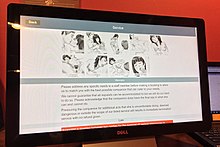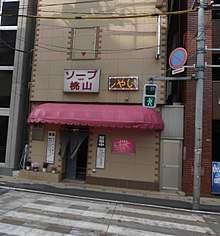Types of prostitution in modern Japan
Prostitution in modern Japan is made illegal by article 3 of the Anti-Prostitution Law (売春防止法, Baishun Bōshi Hō) of 1956.[1][2] However, the definition of prostitution is strictly limited to coitus with an 'unspecified person'.[1][3][4] This means that the sale of numerous acts such as oral sex, anal sex, mammary intercourse and other non-coital sex acts is legal. The Businesses Affecting Public Morals Regulation Law of 1948 (風俗営業取締法, Fūzoku Eigyō Torishimari Hō), also known as the "Law to Regulate Adult Entertainment Businesses", amended in 1985, 1999 and 2005,[5] regulates these businesses.[6]

Since sexual intercourse for money is officially prohibited, the sex industry in Japan has developed into a variety of forms. Soaplands are bath houses where customers are soaped up and serviced by staff. Fashion health shops and pink salons are notionally massage or esthetic treatment parlors; image clubs are themed versions of the same. Call girls operate via delivery health services. Freelancers can get in contact with potential customers via deai sites (Internet dating sites).
Delivery health
Delivery health (デリバリーヘルス, Deribarii herusu), also known as "shutchō health" (出張ヘルス) or by the abbreviation "deriheru" (デリヘル), is a form of prostitution in Japan similar to fashion health, "health" being a term for sexual services.[7] The difference being that the brothel has no premises and is essentially a call girl (or "escort service") with women being dispatched to their customers' homes or to hotels.[8][9]
Outcall call girl businesses distribute advertising handouts to home and apartment mailboxes, telephone booths, public toilets and the like in big cities in Japan. There are also numerous websites to find these businesses or other similar businesses.
Fashion health
Fashion health (ファッションヘルス, fasshon herusu), or health for short, is a form of massage parlor which circumvents Japanese anti-prostitution laws by offering a range of services that stop short of sexual intercourse.[10]
Fashion-health clubs can be found in all large cities in Japan and are easy to spot because of their bright flashing lights and garish decor. Often advertised as "health clubs", they may confuse foreigners unfamiliar with the activities inside. These clubs usually post pictures of their so-called masseuses near the entrance; however, sometimes faces and eyes are censored with pixellation or black strips. Some club entrances feature caricatured depictions of the services provided.
Image club

An image club (イメージクラブ, imējikurabu), or imekura (イメクラ), is a type of brothel in Japan similar to fashion health parlors. They differ in that image clubs are themed along popular sexual fantasies such as an office, a doctor's surgery, a classroom, or a train carriage. The workers themselves, whose activities are usually limited to oral sex, wear exaggerated costumes appropriate to the setting and the desire of the customer.[11] Image clubs simulating molestation of female train passengers became popular in the wake of stricter enforcement of laws against groping on trains.[12]
Image clubs may offer itemized pricing for particular services such as taking instant photographs, removing a woman's underwear or taking it home.[12] Women working at image clubs are paid around 30,000 to 35,000 yen per day and may make more than 1 million yen per month.[13]
Pink salon

A pink salon (ピンクサロン, pinkusaron), or pinsaro (ピンサロ) for short, is a type of brothel in Japan which specialises in oral sex.
Pink salons skirt laws against prostitution by serving food, operating without showers or private rooms, and limiting the services provided to fellatio.[14] There may also be additional activities such as fingering the "companion" and sumata. They exist all over Japan and women who work in them may service a dozen or more men per shift.[15]
Soapland

Soapland (ソープランド, sōpurando), or sōpu, is a Japanglish word constructed from the two English words "soap" and "land".[10]
There are various kinds of soaplands, and they are usually located in complexes with varying numbers of soaplands. Well-known complexes are located in Susukino in Sapporo, Yoshiwara and Kabukicho in Tokyo, Kawasaki, Kanazuen in Gifu, Ogoto in Shiga, and Fukuhara in Kobe, Sagaminumata in Odawara, and Nakasu in Fukuoka, but there are many other areas, especially in onsen ("hot springs") towns.[16] Although the main clientele for soaplands are males, there are also a few soaplands specifically for female clients.[17] Prices for a session at a soapland vary depending on location, time of day, rank of provider, and length of the session.
Legal loophole
Although any sex between 'unspecified persons' is prohibited, it is not between 'specified persons' (acquaintances). In his book, Fuzoku Eigyo Torishimari (Control of Sex Business Operations), Kansai University professor Yoshikazu Nagai, documents that Soaplands exploit this to provide intercourse. The customers pay an entry fee to 'use the bathing facilities' and a separate fee to the masseuse. Whilst the massage takes place, the two become 'acquainted' so any paid sexual services that follow are not viewed as prostitution as defined by the law. This interpretation of the law has been in use since the 1960s.[10]
Origins
Soaplands began when explicit prostitution in Japan became illegal in 1958, as a simple form of bath where women washed men's bodies. They were originally known as toruko-buro, meaning Turkish bath. Following a 1984 campaign by Turkish scholar Nusret Sancaklı denouncing the use of this name for brothels, the new name "soapland" was the winning entry in a nationwide contest to rename them.[18]
Sumata
Sumata (素股, "bare crotch")[19] or intercrural sex in English translation[20] is a Japanese term for a non-penetrative sex act popular in Japanese brothels. It is a form of frottage performed by a female sex worker upon a male client. The sex worker rubs the client's penis with her thighs (intercrural sex) and labia majora.[21][19] The goal is to stimulate ejaculation without penile-vaginal penetration. This activity circumvents the Anti-Prostitution Law (売春防止法, Baishun-bōshi-hō) of 1956, which prohibits sexual intercourse for money.[22]
See also
References
- "5: The definition of prostitution is applied to limited sex acts (e.g. Japan)". Sexuality, Poverty and Law. Retrieved 21 September 2018.
- For the name, see WWWJDIC (link Archived 3 January 2015 at the Wayback Machine)
- Ministry of Justice (Hōmushō), Materials Concerning Prostitution and Its Control in Japan. Tokyo: Ministry of Justice, 1957, p. 32. OCLC no. 19432229.
- Sanders 2003, p. 41.
- Hartley, Ryan (Spring 2005). "The politics of dancing in Japan" (PDF). The Newsletter (70).
- Sanders 2003, p. 28.
- McLelland, Mark J. (2005). Queer Japan from the Pacific war to the internet age. Asian voices. Rowman & Littlefield. p. 201. ISBN 978-0-7425-3787-3.
- Kawakami, Sumie (2007). Rutledge, Bruce (ed.). Goodbye Mme. B.: sex, marriage and the modern Japanese woman. Chin Music Press. p. v. ISBN 978-0-9741995-3-5.
- Bryan, Stefhen Fd (2008). Burton, Susette (ed.). Black Passenger Yellow Cabs: Of Exile and Excess in Japan. Kimama Press. p. 318. ISBN 978-0-615-26810-1.
- Hongo, Jun (27 May 2008). "Law bends over backward to allow 'fuzoku'". The Japan Times Online. Retrieved 24 March 2018.
- Kristof, Nicholas (2 April 1997). "A Plain School Uniform as the Latest Aphrodisiac". New York Times. Retrieved 6 January 2014.
- Wood, Gaby (1 April 2001). "Sex and the city". The Guardian. Retrieved 6 January 2014.
- "Sex-service recruit rags sizzle in summer". The Tokyo Reporter. 1 August 2008. Retrieved 6 January 2014.
- "Blowjob bars around the world: Where they are, how they work". Rockit Reports. November 19, 2012. Retrieved February 27, 2015.
- "Interview with a Japanese Blowjob Bar (Pink Salon/Pinsaro) Worker". Rockit Reports. November 21, 2012. Retrieved February 27, 2015.
- Takahashi, Amy (16 January 2011). "Japan's erotic onsen offerings losing steam but still rise to occasion". The Tokyo Reporter. Retrieved 24 March 2018.
- De Mente, Boyé Lafayette (15 November 2006). "Chapter 8: Love Hotels & Massage Parlors". Sex and the Japanese: The Sensual Side of Japan. Rutland, Vermont, USA: Tuttle Publishing. p. 58. ISBN 978-0-8048-3826-9. LCCN 2009417728. OCLC 71239207.
- Constantine, Peter (1993). "Chapter 2: Soaplands". Japan's Sex Trade: A Journey Through Japan's Erotic Subcultures (1st ed.). Tokyo: Yenbooks. pp. 37–38. ISBN 978-4-900737-00-6. OCLC 37135004.
- 素股. Daijisen (in Japanese). Retrieved 2012-03-21.
- "素股". Jisho. Retrieved 10 May 2020.
- Constantine, Peter. Japan's Sex Trade: A Journey Through Japan's Erotic Subcultures. Tokyo: Yenbooks, 1993, p. 75. ISBN 978-4-900737-00-6.
- Ministry of Justice (Hōmushō), Materials Concerning Prostitution and Its Control in Japan. Tokyo: Ministry of Justice, 1957, p. 32. OCLC no. 19432229. Cited in Sanders, Holly. "Indentured Servitude and the Abolition of Prostitution in Postwar Japan" Archived 2011-11-21 at the Wayback Machine. Cambridge, Massachusetts: Program on U.S.-Japan Relations, Harvard University, 2006, p. 41.
Further reading
- Allison, Anne (1994). Nightwork: sexuality, pleasure, and corporate masculinity in a Tokyo hostess club. University of Chicago Press. pp. 131–132. ISBN 978-0-226-01487-6.
- Bornoff, Nicholas, Pink Samurai: Love, Marriage, and Sex in Contemporary Japan, New York: Pocket Books, 1991, ISBN 0-671-74265-5
- Enz, Lorenzo Enzo. "Pink Salons in Tokyo Japan." My Sexpedition. N.p., 19 Dec. 2014. Web. 30 July 2017.
- Hill, Jane H.; Mistry, P. J.; Campbell, Lyle, eds. (1998). The Life of language: papers in linguistics in honor of William Bright. Trends in linguistics: Studies and monographs. 108. Walter de Gruyter. p. 127. ISBN 978-3-11-015633-1.
- Hosoda, Naomi Bakan. The International Division of Labour and the Commodification of Female Sexuality: The Case of Filipino Women in the Japanese Entertainment Industry. Dissertation, Ottawa, Ontario. ProQuest Dissertations Publishing, 1994. Web. 21 July 2017.
- Kempadoo, Kamala; Doezema, Jo, eds. (1998). Global sex workers: rights, resistance, and redefinition. Routledge. pp. 178–179. ISBN 978-0-415-91828-2.
- Rubin, Samantha. Jon Inc.: The Making of Japan's Salaried Men into Clients of High School Prostitutes. Dissertation, Rep. Alberta. ProQuest Dissertations, 2002. 20th Century Drama [ProQuest]. Web. 21 July 2017.
- Sanders, Holly (2006). "Indentured Servitude and the Abolition of Prostitution in Postwar Japan" (PDF). Cambridge, Massachusetts: Program on U.S.-Japan Relations, Harvard University. pp. 28, 41. Archived from the original (PDF) on 21 November 2011.
- Schreiber, Mark. "In the Pink." The Japan Times. The Japan Times, 8 July 2001. Web. 30 July 2017.
- Talmadge, Eric, Getting Wet: Adventures in the Japanese Bath, Tokyo: Kodansha International, 2006, Chapter 9: "Dirty Waters", pp. 180–98, ISBN 978-4-7700-3020-7